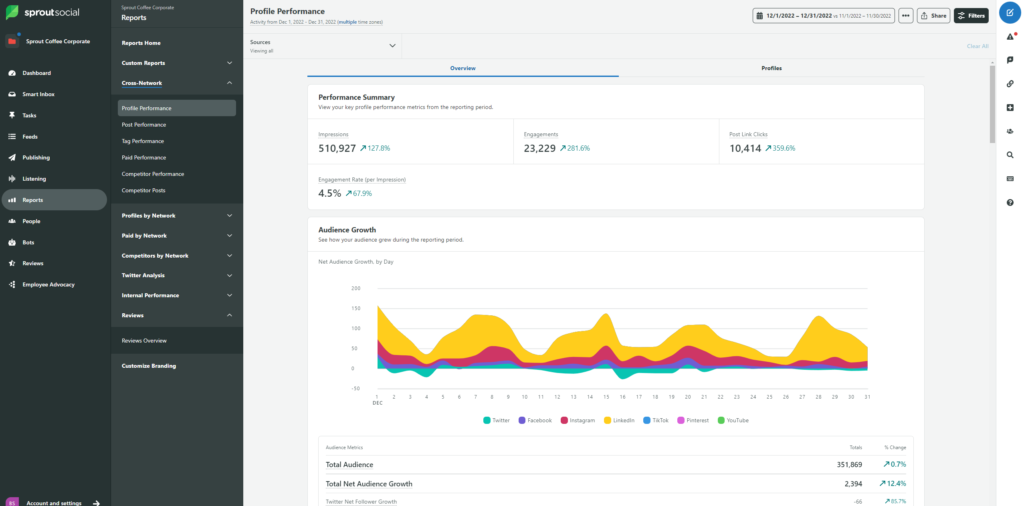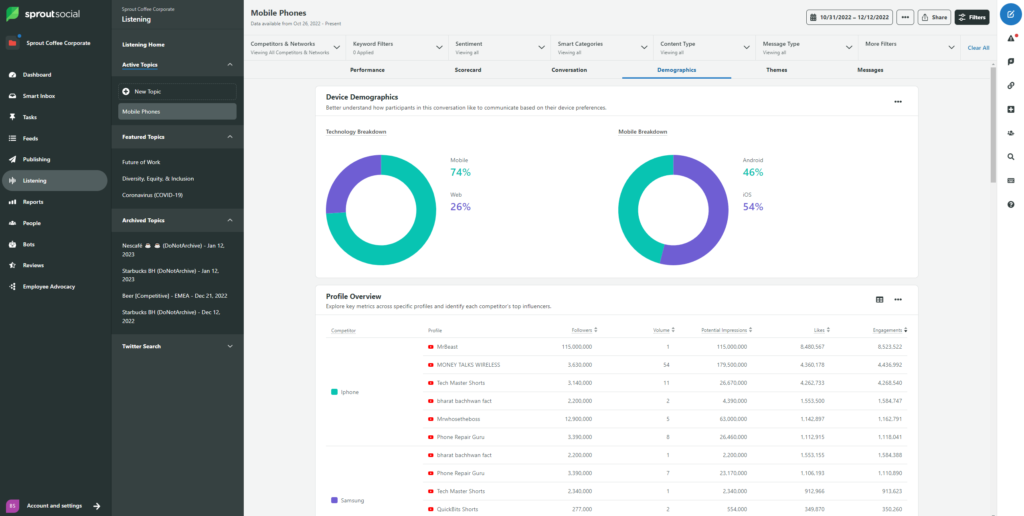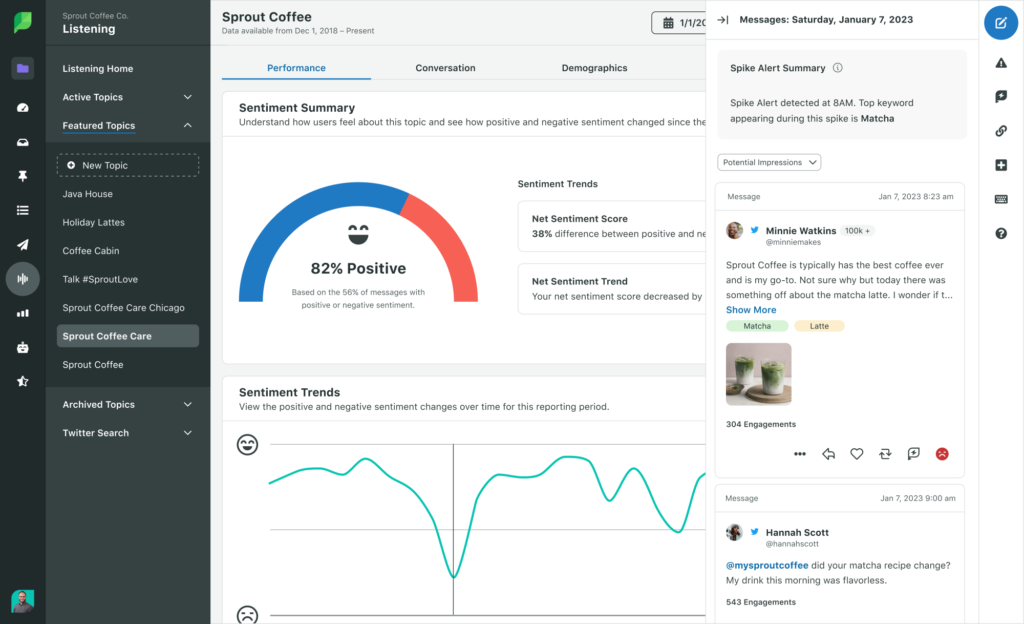In an increasingly digital world, understanding the importance of social media analytics in marketing strategy is vital. By collecting data and metrics, social media analytics provides valuable insights that inform marketing decisions, help plan effective campaigns, and measure performance. Tracking social analytics offers a range of benefits, including trendspotting, monitoring brand sentiment, measuring value perception, setting social media goals, and proving ROI. To achieve this, various types of social media analytics are utilized, such as performance analysis, audience analytics, competitor analysis, paid social analytics, influencer analysis, and sentiment analysis. With tools like Sprout Social offering cross-channel analytics and advanced listening capabilities, and Google Analytics measuring website traffic and conversion rates, utilizing social media analytics is essential for staying ahead in the digital marketing landscape.

This image is property of media.sproutsocial.com.
Benefits of Social Media Analytics
Social media analytics refers to the collection of data and metrics that help measure social media performance. It plays a crucial role in informing marketing strategy, planning campaigns, and generating insights. By analyzing the data gathered from social media platforms, businesses gain valuable insights into their audience, competitors, and the performance of their marketing efforts. Here are some key benefits of using social media analytics:
Trendspotting
One of the significant advantages of social media analytics is the ability to spot trends. By monitoring social media conversations and the behavior of your target audience, you can identify emerging trends in your industry. This information can help you stay ahead of the competition and adapt your marketing strategies accordingly. For example, if you notice a growing interest in a particular product or topic, you can tailor your content and campaigns to capitalize on that trend.
Monitoring brand sentiment
Social media analytics allows you to monitor brand sentiment, which refers to the overall perception and opinion of your brand among social media users. By analyzing mentions, comments, and feedback, you can identify positive and negative sentiments towards your brand. This information is invaluable for managing your reputation and addressing potential issues or concerns raised by customers. By promptly addressing negative sentiment, you can prevent it from escalating and protect your brand’s reputation.
Measuring value perception
Understanding how your audience perceives the value of your products or services is essential for developing effective marketing strategies. Social media analytics provides insights into how your audience talks about your brand, the features they value the most, and the benefits they associate with your offerings. By identifying the aspects that resonate the most with your audience, you can highlight them in your marketing materials and align your messaging with their needs, increasing the perceived value of your brand.
Setting social media goals
Social media analytics helps you set realistic and measurable goals for your social media campaigns. By analyzing data on engagement metrics, reach, impressions, and click-through rates, you can set specific targets and track your progress towards achieving them. For example, if your goal is to increase brand awareness, you can set a target for a certain number of impressions or reach. By closely monitoring your performance against these goals, you can make data-driven adjustments to your strategies to optimize your social media presence.
Proving ROI
Measuring the return on investment (ROI) of your social media efforts is crucial for justifying your marketing budget and demonstrating the value of your campaigns. Social media analytics provides the data and metrics needed to calculate the ROI of your activities. By tracking engagement metrics, website traffic, conversions, and other relevant metrics, you can assess the effectiveness of your social media campaigns and demonstrate their impact on your business’s bottom line.
Types of Social Media Analytics
Social media analytics encompasses various types of analysis that provide insights into different aspects of your social media performance. Here are some key types of social media analytics to consider:
Performance analysis
Performance analysis focuses on tracking and analyzing the performance metrics of your social media campaigns. This includes metrics such as likes, shares, comments, reach, impressions, and click-through rates. By monitoring these metrics, you can assess the effectiveness of your content and the engagement level of your audience. Performance analysis helps you identify which types of content resonate the most with your audience and provides insights into areas for improvement.
Audience analytics
Audience analytics involves analyzing the demographics, interests, and behavior of your social media audience. By understanding your audience’s characteristics, you can tailor your content and campaigns to better meet their needs and preferences. Audience analytics can provide insights into factors such as age, gender, location, language, and interests, allowing you to create targeted and personalized messaging. Understanding your audience helps you build meaningful connections and foster engagement with your target market.
Competitor analysis
Competitor analysis entails monitoring and evaluating the social media strategies and performance of your competitors. By analyzing their presence, content, engagement metrics, and audience demographics, you can identify areas where your competitors are excelling and areas where you have a competitive advantage. Competitor analysis helps you benchmark your performance against industry leaders and identify opportunities for differentiation and improvement.
Paid social analytics
Paid social analytics focuses on analyzing the performance and ROI of your paid social media campaigns. This includes tracking metrics such as cost per click (CPC), conversion rates, return on ad spend (ROAS), and other relevant metrics. By analyzing the data from your paid campaigns, you can optimize your budget allocation, targeting strategies, and ad creatives to maximize the impact of your advertising efforts.
Influencer analysis
Influencer analysis involves identifying and assessing the effectiveness of influencers in your industry or niche. By analyzing metrics such as engagement rates, follower growth, and audience demographics, you can identify influencers who have the potential to reach and resonate with your target audience. Influencer analysis helps you leverage the power of influencers to amplify your brand’s message and increase your reach and visibility.
Sentiment analysis
Sentiment analysis focuses on monitoring and evaluating the sentiment or emotional tone of social media conversations related to your brand. By analyzing mentions, comments, and feedback, you can identify positive and negative sentiments towards your brand. Sentiment analysis helps you understand how your brand is perceived by your audience and enables you to address any negative sentiment or concerns promptly.

This image is property of media.sproutsocial.com.
Social Media Analytics Tools
To effectively analyze and derive insights from social media data, businesses rely on specialized social media analytics tools. These tools provide features and functionalities that simplify the process of collecting, organizing, and analyzing data. Here are two recommended social media analytics tools:
Sprout Social
Sprout Social is a comprehensive social media analytics tool that offers a range of features to help businesses analyze their social media performance. Some key features of Sprout Social include:
Cross-channel analytics
Sprout Social allows you to monitor and analyze data from multiple social media platforms in one place. This enables you to gain a holistic view of your social media performance and compare the effectiveness of your campaigns across different platforms.
Automated reports
Sprout Social provides options to generate automated reports that present your social media performance metrics in an easy-to-understand format. These reports can be scheduled to be delivered to your inbox or shared with team members, saving you time and effort in compiling and analyzing data manually.
Advanced listening capabilities
Sprout Social includes advanced listening capabilities that allow you to monitor social media conversations and mentions of your brand, industry, or competitors. This enables you to gain valuable insights into customer sentiment, industry trends, and competitor strategies.
Google Analytics
While primarily known as a website analytics tool, Google Analytics also provides valuable insights into social media performance. Here are two key areas where Google Analytics can contribute to social media analytics:
Measuring website traffic
Google Analytics allows you to track and analyze the traffic coming to your website from social media platforms. This includes insights into the number of visits, bounce rates, average time on site, and conversion rates from social media sources. By monitoring these metrics, you can assess the effectiveness of your social media campaigns in driving traffic to your website.
Measuring conversion rates from social media sources
Google Analytics provides data on the conversions that occur as a result of your social media activities. This includes tracking the number of goal completions, e-commerce transactions, and other relevant conversion metrics. By analyzing conversion rates, you can identify which social media channels or campaigns are driving the most valuable conversions and optimize your strategies accordingly.
Informing Marketing Strategy
Social media analytics plays a vital role in informing marketing strategy by providing valuable insights into the target audience and competitive landscape. Here are three ways social media analytics can inform your marketing strategy:
Understanding audience demographics
By analyzing the demographics of your social media audience, you can gain a better understanding of who your customers are. Social media analytics tools provide data on age, gender, location, language, and other demographic attributes of your audience. This information helps you create targeted and personalized marketing campaigns that resonate with your target market.
Identifying trending topics and interests
Social media platforms are rich sources of real-time information on the latest trends and interests. By monitoring social media conversations and analyzing hashtags and trending topics, you can identify the subjects and themes that are capturing the attention of your target audience. This knowledge allows you to align your marketing content and campaigns with these trends, increasing the relevance and engagement of your messaging.
Assessing effectiveness of marketing campaigns
Social media analytics provides a reliable way to evaluate the effectiveness of your marketing campaigns. By tracking engagement metrics such as likes, shares, comments, and click-through rates, you can measure the impact of your campaigns and gauge the level of audience engagement. This data helps you identify which campaigns are resonating the most with your audience and informs future campaign strategies.

This image is property of media.sproutsocial.com.
Planning Campaigns
Effective campaign planning is crucial for achieving desired marketing outcomes. Social media analytics can significantly contribute to the success of your campaigns by providing data-driven insights. Here are three ways social media analytics can help in planning campaigns:
Identifying target audience
Social media analytics tools offer audience analytics features that allow you to gather information about your target audience. By analyzing demographics, interests, and behavior, you can identify key characteristics of your audience and tailor your campaigns to meet their preferences. Understanding your target audience helps you create targeted messaging and choose the appropriate social media platforms to reach them.
Determining optimal communication channels
Different social media platforms attract different audiences and have varying strengths and weaknesses. By analyzing social media data, you can determine which platforms are most popular among your target audience. This knowledge allows you to prioritize your resources and focus your efforts on the channels that are most likely to reach your audience effectively.
Crafting tailored content based on audience insights
Once you have a deep understanding of your target audience, social media analytics can help you craft tailored content that resonates with them. By analyzing the performance of your previous content, you can identify the types of posts, images, and videos that generate the most engagement. This data-driven approach ensures that your content is well-received and has a higher chance of achieving your campaign objectives.
Generating Insights
Social media analytics provides valuable insights that can inform various aspects of your marketing strategy. Here are three ways social media analytics generates valuable insights:
Identifying patterns and trends
By analyzing social media data, you can spot patterns and trends that can inform your marketing strategies. Is there a particular type of content that consistently performs well? Are there patterns in the time of day or the days of the week when your audience is most active? By identifying these patterns, you can optimize your content and posting schedule to maximize engagement and reach.
Recognizing content that resonates with the audience
Social media analytics allows you to understand which content resonates the most with your audience. By analyzing engagement metrics such as likes, shares, and comments, you can identify the types of content that generate the most positive response. This knowledge enables you to create more of the content that your audience finds valuable and engaging, increasing the likelihood of building brand loyalty and driving conversions.
Informing future marketing strategies based on data-driven insights
Data-driven insights from social media analytics empower you to make informed decisions about your marketing strategies. By using the insights gained from analyzing social media data, you can adjust your messaging, campaign tactics, and target audiences to optimize your marketing efforts. Furthermore, social media analytics can help you identify new opportunities and areas for growth, allowing you to stay ahead in a fast-paced and ever-evolving digital landscape.

This image is property of media.sproutsocial.com.
Performance Analysis
Performance analysis is a crucial aspect of social media analytics that focuses on monitoring and analyzing the performance metrics of your social media campaigns. By tracking key performance indicators (KPIs), you can assess the effectiveness of your content and engagement level of your audience. Here are three key metrics to consider when conducting performance analysis:
Tracking engagement metrics (likes, shares, comments)
Engagement metrics, such as likes, shares, and comments, provide insights into the level of interaction and interest your content generates among your audience. By tracking these metrics, you can identify which posts and content formats resonate the most with your audience. This information can help you optimize your content strategy by creating more of the content that your audience engages with the most.
Monitoring reach and impressions
Reach refers to the number of unique users who have seen your content, while impressions represent the total number of times your content has been shown. By monitoring these metrics, you can assess the visibility and exposure of your content. Understanding the reach and impressions of your content helps you evaluate the effectiveness of your distribution strategies and adjust your targeting or posting frequency if necessary.
Analyzing click-through rates
Click-through rates (CTRs) measure the percentage of users who clicked on a call-to-action or a link included in your post. By analyzing CTRs, you can assess the effectiveness of your content in driving traffic to your website or specific landing pages. This metric helps you gauge the level of interest and intent among your audience and provides insights into the success of your conversion-focused objectives.
Sentiment Analysis
Sentiment analysis is a valuable tool in social media analytics that helps monitor and evaluate the sentiment or emotional tone of social media conversations related to your brand. By analyzing mentions, comments, and feedback, you can identify positive and negative sentiments towards your brand. Here are three ways sentiment analysis can be beneficial:
Monitoring brand sentiment online
Brand sentiment refers to the overall perception and opinion of your brand among social media users. Sentiment analysis allows you to monitor and track brand sentiment in real-time. By analyzing social media conversations and mentions, you can gauge the sentiment towards your brand and identify any positive or negative trends. This information enables you to take proactive measures to address concerns or amplify positive sentiment.
Identifying positive and negative mentions
Sentiment analysis helps you identify both positive and negative mentions of your brand on social media. By monitoring the sentiment associated with your brand, you can quickly identify when your brand is being praised or receiving negative feedback. This allows you to take appropriate action, such as thanking customers for positive feedback or addressing concerns raised by customers who have expressed negative sentiment. By promptly responding to negative sentiment, you can prevent it from escalating and mitigate any potential damage to your brand’s reputation.
Addressing customer concerns or complaints
Sentiment analysis helps you identify and address customer concerns or complaints. By understanding the sentiment associated with mentions and comments, you can identify customers who are dissatisfied or experiencing issues with your product or service. By promptly addressing their concerns and providing support, you can turn a potentially negative situation into a positive one. This demonstrates your commitment to customer satisfaction and can contribute to building strong customer relationships.

This image is property of media.sproutsocial.com.
